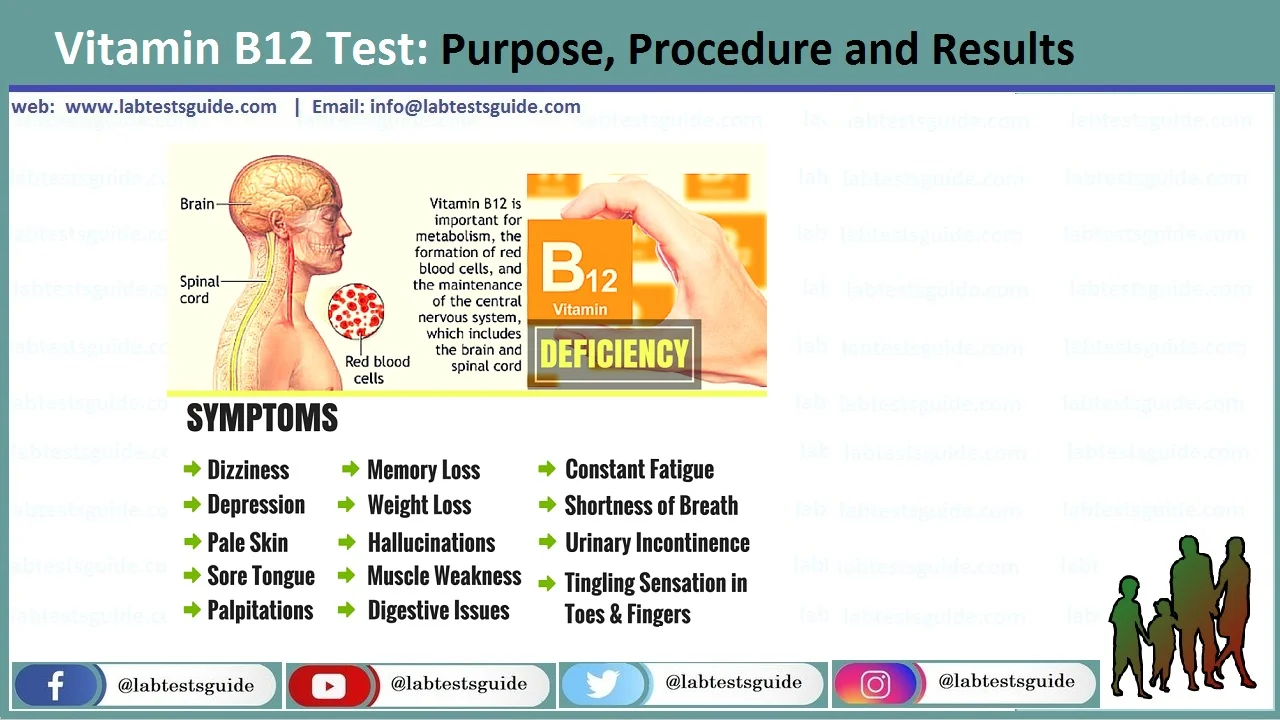Vitamin B12 is vital for good health. Your body needs steady levels of this nutrient to make enough red blood cells and keep your nervous system working.
For most people who eat a balanced diet, low B12 levels are rare. But there are reasons why they may dip below normal. A simple blood test can show whether your levels are healthy, low or somewhere in between.

Also Known As: Cobalamin, Folic Acid, RBC Folate, Folacin, Vitamin B9
Why Get Tested:
- To help diagnose one cause of anemia
- To help diagnose one cause of neuropathy
- To evaluate nutritional status in some people
- To monitor the effectiveness of treatment for vitamin B12
- To monitor the effectiveness of treatment for folate deficiency
When does your doctor order a vitamin B-12 test?
Your doctor might recommend a B-12 test if you have:
- Tingling in the hands and feet
- Problems with balance
- A racing heart
- Confusion
- Dementia
- Weakness
- Loss of appetite
You may also take this test if your doctor suspects you might have pernicious anemia. Pernicious anemia is a reduction in red blood cells. It occurs when your intestines can’t absorb vitamin B-12, which is necessary for red blood cell production. Symptoms are not often seen in people younger than 30 years old. The average age of diagnosis is 60.
Symptoms of this condition include:
- diarrhea or constipation
- exhaustion
- loss of appetite
- pale skin
- inflamed red tongue, or gums that bleed
Sample Required:
- B12 estimation is done on the serum of the patient.
- A fasting blood sample is needed.
- The specimen is stable for 8 weeks at 8 °C.
- 24 hours of urine samples are collected.
Precautions:
- Avoid hemolysis.
- Protect the sample from the light.
- Avoid heparin, fluoride, and ascorbic acid.
- Drugs like chloral hydrate increase the B12 level.
- Drugs that decrease the level are alcohol, anticonvulsants, colchicine, oral contraceptives, and aminoglycosides.
Normal Range:
Source 1
| Age | pg/mL |
| Newborn | 160 to 1300 |
| Adult | 200 to 835 |
| 60 to 90 years | 110 to 770 |
Other sources
- Newborn = 160 to 1300 pg/mL, (118 to 959 pmol/L)
- Adult = 200 to 835 pg/mL (148 to 616 pmol/L).
- Critical value :
- Decreased B12 level = <100 pg/mL.
- Increased B12 level = >700 pg/mL.
- Some references use:
- Normal value as 200 to 900 pg/mL OR
- Other sources = 206 to 678 ng/L.
- Another reference = 110 to 800 pg/mL.
- Normal value as 200 to 900 pg/mL OR
Diagnosis:
- The indirect method measures the urinary and serum levels of methylmalonic acid and homocysteine.
- The Patient deficient in vitamin B12 secrete an excess amount of methylmalonic acid in the urine. Methylmalonic acid can be measured by gas chromatography.
- Homocysteine level is increased in patients deficient in vitamin B12. Because their cells can not metabolize homocysteine to methionine at a normal rate.
- Vitamin B 12 absorption test known as the Schilling test.
- This test can differentiate:
- B12 deficiency (Pernicious anemia)
- Intestinal malabsorption.
- Diet.
- This test can differentiate:
How to manage your B-12 levels
For people with high levels of B-12, treatment involves adjusting your diet. This may mean eating less animal products like meats, dairy, and seafood.
If you’re diagnosed with a B-12 deficiency, the goal of treatment is to increase your level of vitamin B-12. Your treatment may include:
- vitamin B-12 injection, with more frequent injections for those with severe deficiencies
- daily vitamin B-12 supplements, such as Cyanocobalamin, which is a manmade vitamin B-12
- regular administration of liquid B-12 through the nose
- adhering to a diet rich in vitamin B-12
Possible References Used




